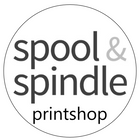PDF Stitcher: Advanced Moves
I wrote about PDF Stitcher when I first learned about it, and included some info about how to use this free open-source software. It's a great tool for stitching together your letter-sized tiles of sewing patterns, into large-format pages! For the basics, check out the earlier post.
In that example, I used a fairly simple pattern that worked out great on the first try, since it has no-trim pages. But a lot of patterns are not so easy to fit together with software, so I wanted to show you some tricks I've learned!
Same disclaimer applies: This is open-source software, and I am not in any way associated with its maker. I just like to use it for myself! Spool & Spindle will not use this program to stitch your patterns together. And we will do our best to print patterns that you send us after using this software, but we can't guarantee perfection. We only print what you provide.
For this example, I'm using the Friday Pattern Co Adrienne Blouse. I have personally purchased (and sewn) this pattern. In this post, I'm only going to show partial screenshots, since this is a paid pattern. Note that it does come with an A0 version, so this stitching isn't strictly necessary, it's just for demo purposes.

The instructions doc for the pattern includes a layout of how to tape the letter-sized pages together, and it shows 4 columns. So using the basic settings of 4 columns, all pages, no trim or overlap, this is what I get.
There are a few issues, the first one being that there are gaps between each page, on the sides and the top/bottom. I can use the Trim feature to remove those!
Here is how I start:
- I always choose Overlap instead of Trim, since it's helpful to see how far off I am. You may need to choose Trim if the overlapping parts do not have transparent backgrounds.
- A typical setting is 1" or 0.5", so try that first, then look at the output to see how close you are.
- The vertical and horizontal overlap amounts are often different, but you typically want the same number for left/right and for top/bottom.
- You might have to try lots of times to get this to work, that's okay! Remember to close the generated PDF every time, the program can't overwrite an open PDF.

Many patterns have visual indicators like this one, where the gray triangles should meet and make a perfect square. Zoom in to make sure the squares are right, looking at at least one horizontal and one vertical join.
Looks good! But there's something weird going on at the bottom of the page. To save on blank paper, the tiles of this pattern leave some blank spaces with no page to print. We can fake that by putting as many copies as we need of page #0 in the "Page Range" field.

In this example, I need to have pages 1-11, then a blank page 0, then pages 12-14. There's also a blank page 0 after page 14, but we can leave that out.
Now that looks right! Here are the settings for this one:

Secondary Feature: Layers
Another helpful feature of this software, especially for projector sewists, is the ability to hide or delete extra size layers from a file. Not every designer uses size layers in their PDFs, so sometimes the layer feature doesn't work.
If the file has size layers, you can delete the extra ones, and even change the colour, thickness, or dash style of the remaining line(s). Especially if you only need one size, this can make a hard-to-see yellow or light grey dashed line into a high-contrast solid black line.

Of course, if you are sending your pattern to Spool & Spindle for printing, you don't have to use this feature to change the visibility of size layers. You can just include a note about what size(s) you want, and we can hide the other layers when we print (again, assuming the file has layers).
Other possible issues:
It's inevitable, there are always going to be files that don't quite work. This software assumes that each page uses the same margin width on the same sides, but sometimes designers fudge things a little. Or I've seen tiled versions where some pages are rotated to fit on fewer pages.
In those cases, you might be able to use a different program to fix up the individual pages, then put that resulting PDF into PDF Stitcher. Rotating is easy with a pro version of Adobe Acrobat. Resizing margins can be trickier, to make sure you do it without resizing any pieces!
My advice in those cases is often to just print the tiles and tape them together, unfortunately. Or you could stitch it so some pages have to be cut apart or have margins folded under, but honestly, this can be more work in the long run.
I hope this info helps you get the most enjoyment out of your sewing patterns! With more and more designers switching from print to digital-only pattern delivery, and not all including a large-format version, it's good to know some tricks that let you skip all that taping!
If you have further questions, feel free to email us at info@spoolandspindle.com. We will do our best to help out, but as we said above, we can't use this software for you.

